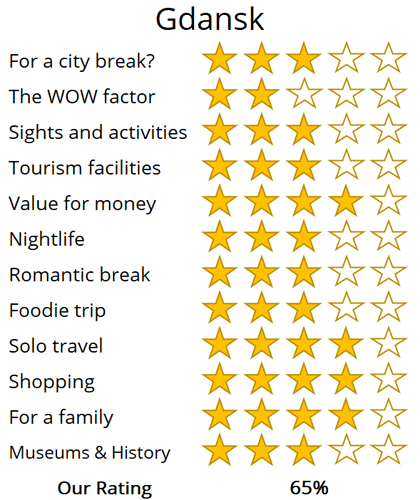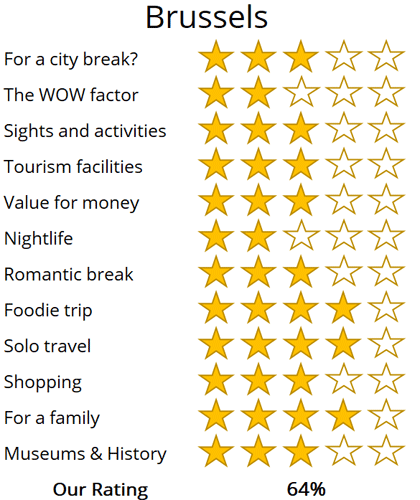WhereToGoForMyHoliday.com
The best destination comparison site!
WhereToGoForMyHoliday.com
The best destination comparison site!
Gdansk or Brussels, which is better for your holiday in 2024?
Gdansk and Brussels both offer unique and enticing experiences, but which one should you choose for your city break or holiday?
We recognise the difficulty in making this decision. While there is abundant information available on both destinations, clear guidance on which city better aligns with your travel preferences is often hard to find.
This article aims to provide an impartial comparison of Brussels and Gdansk, and hopefully help you to choose the best city to visit.
The article is structured into several sections, each of which can be directly accessed through the following links:
• Introduction to the cities
• Scores and ratings
• Which one should I, friends, or family visit?
• When to visit and weather
• Who is the city suited for?
• The perfect 48hours (with map)
• Tourism details (where to stay? airport details?)
Introduction to Gdansk and Brussels
Salt-washed, industrial-chic and filled with hipsters, Gdansk is one of the most happening cities in Poland. It sits on the edge of the Baltic Sea, proudly showcasing its merchant guilds and mansions, a leftover from the years when this was one of the richest ports in the Hanseatic League.
Like most Polish cities, the focal point is an immersive Old Town (also called the Main City) that beats with life and cafés and boutique shops.
Around that's a newer city where the remnants of Communist rule still pop up in the tenement blocks and the famous dockyards where the Solidarity movement heralded the beginning of the end for the USSR in the 1980s.
On top of all the architecture and culture is a vibey bar scene that's powered by a hefty student population. There are clubs and pubs everywhere, from the open-air boats on the quaysides to the hidden basement bars in the old quarter.
What's more, Gdansk is the gateway to the Polish coast, with Hel Peninsular and its oat-topped dunes close by, or the resort town of Sopot only a short train ride away.
It is all too easy to over-look Brussels as a city break destination, especially considering it is the home of modern European politics. However, there is a surprising amount here to explore and enjoy, and a visit here can end up being one of those unexpected hits that with hindsight, you can’t understand why you hadn’t been before.
Being smaller than many of its European counterparts it is able to offer the perks of a more manageable and friendly atmosphere with fewer crowds, exceptional art galleries, museums and medieval churches abundant around every cobbled street corner. It is also brimming with quirky café charm and home to the highest standard of food you will find anywhere in the world.
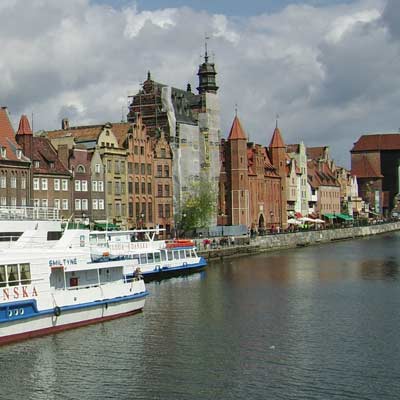
The scenic Długa waterfront in Gdansk

The Mont des Arts gardens in central Brussels
High-level summary for Gdansk and Brussels
Summary
Where would I journey for a personal escape?
Gdansk
Where would I send my parents for a memorable visit?
Gdansk
Where's the ideal destination for my adventurous 19-year-old cousin?
Gdansk
Where should my food-obsessed friend indulge their culinary passions?
Brussels
Note: The above comparisons are weather-independent and are based on travel during the most opportune times of the year. Details about the ideal travel seasons are elaborated upon later in this article.
In the sections that follow, you'll find a comprehensive comparison between these two fascinating cities. This includes recommendations on the duration of stay, the best times to visit, and tailored 48-hour itineraries for each city.
The final segment delves into practicalities for your travels, such as the best airport to fly into, the optimal districts for your accommodation, and insider tips, for when you come to explore the city.
We hope that you find all of this information useful, in planning your next exciting trip!
Destination details
How long to spend each city?
Brussels, with its compact layout, allows visitors to explore its main attractions within 1 or 2 days, primarily centered around the historical core.
A leisurely stroll from the Grote Markt (The Grand Place), the heart of the city, to the EU Parliament, passing through the lively Stalingrad District, takes just a couple of hours—though this may vary depending on your penchant for Belgian beer stops along the way!
If time permits, consider day trips to the historic battlefield of Waterloo or the charming medieval city of Bruges, both offering unique insights into Belgium’s rich heritage.
Gdansk can be done in just a couple of days, but don't expect that to be enough to do everything. You'll likely want to linger longer, if only to beachcomb the Baltic coast, explore the other corners of the Tri-City (Gdansk is just one of three individual towns that are joined together), and sample as many of the cool hipster bars as you can.
Still, city breaks are very much doable here. Just 48 or 72 hours is ample for checking off the historic sights in the centre, the fascinating dockyards monuments, and to get a feel for the unique fusion of Slavic-Germanic architecture that abounds. Expect to do a lot of walking, though, and be ready to hop on inner-city trains and trams to get from A to B.
During the summertime, you could opt to do as thousands of Polish locals do and extend your Gdansk holiday to a week or two. That'll let you head out to the coast and the beaches. They can be surprisingly stunning, especially along the breezy Hel headland.

The Saint Jacques-sur-Coudenberg church, Brussels
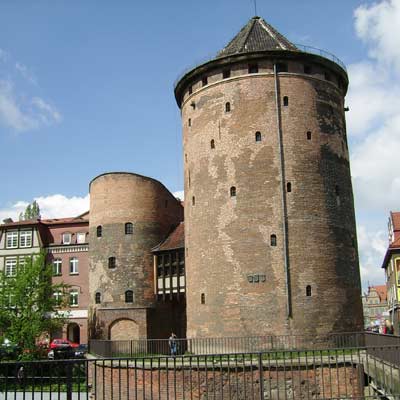
The Stągwie Mleczne was the ancient gateway to the southern side of Gdansk
Gdansk is surely at its best in the warmer months. Between May and September is when most travellers come. They get to enjoy all the al fresco bars along the old port. They can wander the Old Town without worrying (too much, at least) about rain. They can hit the open-air terraces to taste pierogi dumplings. The weather is a little milder than inland Poland thanks to the tempering effect of the Baltic Sea. Average highs in July are in the low 20s, but that's enough to bring crowds to the beaches of Sopot and the north coast.
The winter in Gdansk can be brutal. The Baltic magnetises icy storms and cold winds across the shoreline and the city. It's a time to get cosy in cute cafes and sip warm beers (yes, that's a thing here), but be certain to pack the thermal leggings and snow coats.
Brussels gets busiest during the warm months of the summer. Everyone from city breakers flying in on short-haul budget links to Interrail backpackers on a cross-continent grand tour pass through during the main holidays from June and August.
There's a real buzz about the bars of the Grand Place then, with people chatting and snapping selfies all around the UNESCO-tagged streets. Some downsides: Brussels can have heatwaves, and the price of hotels at this time is sure to be peaking.
While winter is probably best avoided unless you're on the hunt for cosy Christmas markets, spring and autumn have their pluses. They're both typically cheaper. There's fewer people around, so you're more likely to score tours of the EU Parliament and whatnot. And everything costs a little less, from hotels to flights deals into town.
One of the great joys of Brussels is just how many facets there is to the city. You're certain to be entertained if you love architecture. The main square alone comes with Gothic, Neo-Gothic, and Renaissance elements.
Then there's all that fabled Belgian food, from the double-cooked chips to the chocolate-topped waffles to the frothy monk-brewed beers you find in the pubs. Add in enthralling tours of important parliament buildings, pretty parks, and some seriously rich galleries, and you've got a destination suited to all sorts.
Of course, some people might not feel right at home, Brussels is urban to the core. Finally, budget seekers could find themselves a little happier elsewhere. Brussels hardly breaks the bank, but it's no penny saver either.
Gdansk has got loads going for it on the travel front. Melding enthralling medieval history with sobering tales of wartime and the proud trade union movement, it's a gem for those looking to unravel the history of Central-Eastern Europe. Shoppers get to delve into Amber shops galore – the city is hailed as one of the best places in the world to buy the glowing fossil. Hedonists get everything from basement bars to wild clubs in old bunkers that stay open all night. Sightseers need only look to the historic Old Town and its grand churches and squares.
Adding to all that, Gdansk has beaches. A quick train to Sopot will reveal one of the nicest in the region, with a long pier that juts out into the Baltic. A little further and you can get to Puck, which sits at the base of what is arguably Poland's finest length of coastline.
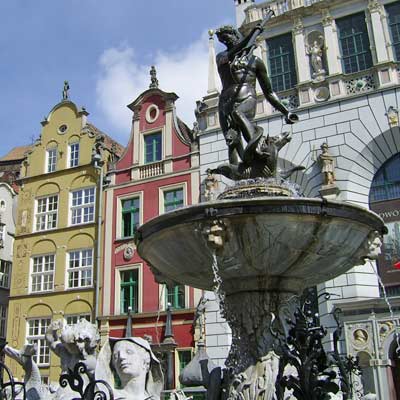
Neptune's Fountain in the historic centre of Gdansk

The Arc de Triomphe leads to the Park du Cinquantenaire
48hours in Brussels
A whirlwind 48 hours in Brussels can take you from curious statues to modernist structures, regal parklands to beautiful palaces. Of course, there's plenty of time to fit in home-brewed beers and indulgent waffles along the way.
Day 1: The Grand Place is the only real place to begin in Brussels. A UNESCO World Heritage Site, it is the kernel of the city, and has been since time immemorial. Look to the north end and you can see the elegant façade of the Brussels City Museum. It's housed in the Neo-Gothic Maison du Roi, hosting collections that include masterworks by Flemish painters and the original Manneken Pis statue (more on him later).
On the south flank is the indomitable Brussels Town Hall. Gaze up at its gorgeous medievalist spire and wonder at the carvings of dukes on the portals. The rest of the square is a photographer's dream, with guild houses and pubs and more. Next, the area of Stalingrad calls. Curiously named, it's nonetheless one of the liveliest quarters of Brussels.
It's also where you'll find the famously underwhelming Manneken Pis statue – we won't spoil it with a description! After lunching in one of the taverns there, head east to the acclaimed Royal Museum of Fine Arts of Belgium. It's a must for any culture vultures, what with exhibits that contain works by the likes of Anthony van Dyck, Bruegel, and Rubens. It demands a whole afternoon.

The town hall on the Grand Place, the main plaza of Brussels
Day 2: Overdosed on art and ready for something completely different? Good, because day two begins at the Espace Léopold. Welcome to the vast European Parliament; the corridors of power for 27 states that range from Romania to Portugal. Tours of the huge debating chamber and the plenary rooms where the decisions are made run daily from 9am.
After an hour inside, you can head for the grand Parc du Cinquantenaire that sits just behind. It's a prime example of Brussels' flamboyant public garden style, hosting the eye-watering Arc du Cinquantenaire, a national symbol of Belgium.
The afternoon sees you hop on trams (a combo of Tram 5 and Tram 6 usually does the trick) to the area of Laeken. This otherwise green a leafy suburb has one major claim to fame: the strange Atomium. You might not believe it, but it was built in 1958. Up top there's a lookout point with panoramas of the whole city.
For the evening, mosey back to the Grand Place and seek out the iconic Delirium Café on the side streets nearby. It's home to a whopping 2,000 variations of Belgian and global beers!

Brussels is the home to the European Parliament
48hours in Gdansk
Gdansk has big-name sights like the iconic dockyards and its Old Town. But it also has secrets up its millennia-old sleeve. This 48-hour itinerary covers both, with a little bit of partying and beachside living thrown in for good measure…
The interactive map below shows a suggested route for the 48 hours in Gdansk, with day 1 highlighted in green and day two in yellow.
Day 1: Make for Cafe Libertas for breakfast. It's a popular spot with fruit bowls and artisan coffee that will fuel you up right in the heart of the Old Town. Stepping outside the door, you'll find quaint Chlebnicka street, which you can stroll between grand townhouses with Flemish-inspired façades.
At one end is Chlebnicka Gate, still flaunting its original medieval crest from 1450. Beyond is the riverside and the iconic Żuraw Crane. Now a branch of the National Maritime Museum, it's a great detour to make if you want to learn all about the history of shipbuilding in Gdansk.
Delve back into the maze of streets to the west and try to find the St. Mary's Church. It shouldn't be difficult – it's among the three largest brick-built churches on the planet! Past that is bustling Długa. The main drag of the city, it's awash with amber shops, bars, eateries and more.
Stop to sample some pierogi dumplings or grab a beer, and then move on to lovely Long Market square. That's where the famous statue of Neptune beckons, hemmed in by pastel-painted guilds. As evening arrives, return to Długa or Piwna street for basement bars that gush with vodka and cheap beer.
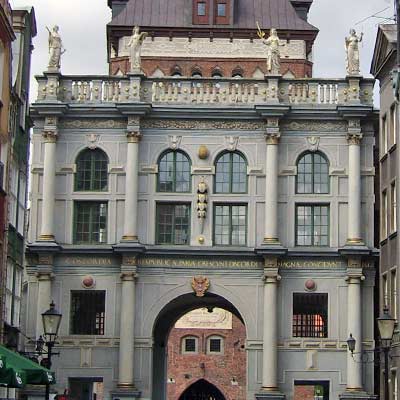
The Złota Brama (Golden Gate) is lined with figures depicting the qualities of the ideal citizen
Day 2: Morning of Day 2 takes you out to the legendary Gdansk Shipyards. If you haven't heard of these already, then buckle in for a history lesson in the fall of Communism. It was here, in 1980, that the powerful Solidarity movement first took route under the leadership of Lech Wałęsa. It would go on to fuel revolutions across the Eastern Bloc, which finished with the fall of the Berlin Wall and the end of Russian dominion in Europe.
There's nowhere better to uncover all that than at the European Solidarity Centre. A visit is likely to take a few hours, especially if you want to drop by the striking Monument to the Fallen Shipyard Workers of 1970 next door. For the afternoon, it's time to explore the Tri-City.
That means hopping on the SKM railway line from Gdańsk Główny. The ride to Sopot is only 15 minutes. It takes you to a lively resort area that's positively brimming with bars and eateries. It's also on the beach, so you might want to spend the evening here, moving between the music venues to famous Sopot Pier.

The European Solidarity Centre commemorates the Polish civil resistance and trade union which began in the Polish shipyards and ultimately led to the collapse of the communism in the USSR

Sopot has a beautiful beach and is an enjoyable destination during the summer season
Brussels Airport (BRU) and the Charleroi Airport (CRL) combine to offer all sorts of long-haul and short-haul air links into the capital. The cheapest cross-continent flights on Ryanair and the like usually jet into CRL. Transatlantic and premium carriers usually go to BRU.
You can use Brussels City Shuttle to get to Charleroi for as little as €5 each way if booked online and in advance. Meanwhile, direct rail links go to Brussels Airport from Brussels Central, costing €8.60 and taking a little over 20 minutes in total.
Most of the sights and attractions on the itinerary above are within walking distance of each other. But be ready to make use of Brussels' efficient public transport system if the legs tire and the rain starts falling, though.
The metro and high-speed tram network links up most areas with its six lines. Tickets can be bought at the GO machines on virtually every station. They need to be validated at the orange boxes before use.

The bars and pubs in the historic centre of Brussels
In terms of travel safety, Brussels ranks well. Incidents involving tourists are rare, although thefts, bag snatches, and pickpocketing do occur in many of the visitor hotspots.
Try not to walk alone in the city centre after dark, particularly if you've been drinking. Never leave valuable items within sight if you're parking your car. Also always keep one eye on your handbag or wallet when riding the metro.
For hotels, the best area of Brussels is surely the district immediately around the Grand Place. The closest establishments to that UNESCO site typically cost oodles but ooze luxury. A few streets back and you can find affordable local B&Bs with plenty of charm.
Getting to Gdansk by plane is easy because of the countless short-haul and low-cost carriers that now fly into the local Lech Wałęsa Airport. A mere nine miles outside of the centre, you can get to the terminals on the 210 bus from the main train station. There are often problems with scam taxi fares to and from the airport, so always agree a rough price beforehand (the normal rate is between 60-80 PLN).
Gdansk's Main City is a joy to walk. The streets of Długa and the quays are all connected by loads of hidden alleys and paths. It might pay to have a tourist map at hand because getting lost is almost inevitable if it's your first time in town.
To travel to the beaches, the shipyards, and Sopot, you'll need to make use of the trams and inter-city SKM trains. The former cost 3.2 PLN per ride. Tickets are available from vending machines at most stations. Be sure to validate as you board.
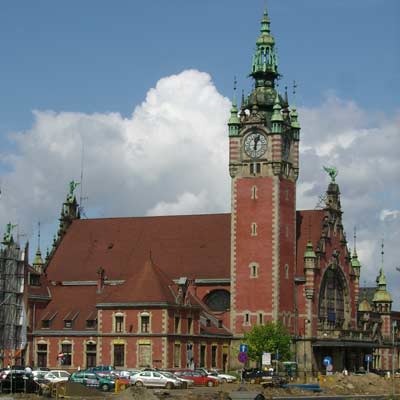
Gdansk Glowny - the main train station of Gdansk
The best location for a hotel in Gdansk is certainly in the Old Town area. There, you'll get boutique lodgings and stylish aparthotels set in centuries-old buildings. An alternative for those who favour beaches and nightlife would be to bed down in Sopot, where resort hotels with swimming pools and stylish restaurants are the norm.
Gdansk is among the most liberal and welcoming of Polish cities. It's got a vibrant LGBT scene and incidents of racism and crime are relatively rare. Still, there are still tensions in Poland and it's wise to be on your guard, especially if out at night in the bars of the Old Town.

oh we were stuck in the airport!

Copenhagen was a bit expensive...

All we did was drink beer in Brussels...

Muncih was crazy

And we got so burnt!

Remeber that night in Rome

oh we were stuck in the airport

So much fun kayaking

Berlin and that group from Austria!

There was such a view from that church

And we got so burnt!

Munich was eventful, wasn't it!

Such a view from that cathedral in Florence

Lisbon was such so much fun

Last summer was so much fun .... x

Remeber that night in Rome

Lisbon was such so much fun

Such a view from that cathedral in Florence

Munich was eventful, wasn't it!

And we got so burnt!

Remeber that night in Rome

All we did was drink beer in Brussels...

Berlin and that group from Austria!

Can't wait to go back to Dubrovnik

Remember that boat ride in Prague

Copenhagen was a bit expensive...
